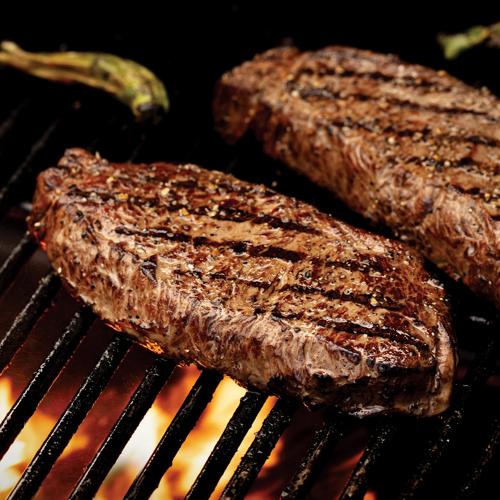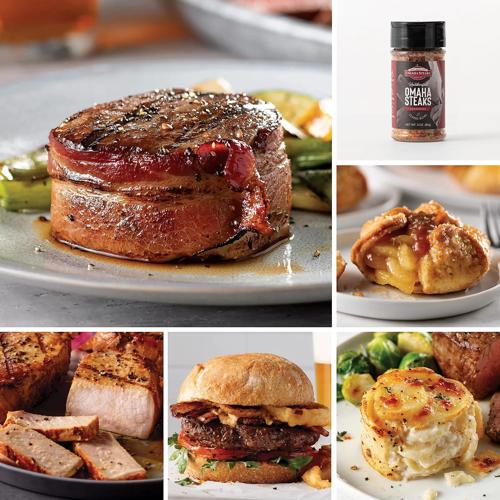Hearing the call of the grill, but don’t know where to start? Craving the flavor of steak but intimidated by how to make it yourself? Don’t worry, we’ll teach you how to grill steaks.
As America’s Original Butcher, Omaha Steaks is much more than a meat market. We’re a family business, and our family’s tradition is helping YOU make incredible steaks. Follow these simple guidelines to choosing, preparing, grilling, and serving the best steaks you’ve ever eaten.
Start With Great Steak
So how do you choose a good steak? You ask America’s Original Butcher, of course.
“Steak” isn’t really a one thing… there are dozens of great cuts of beef, each with a unique flavor profile, cooking style, tenderness, and size. The more you get to know beef – and the tastes of your family and friends – the further you can dive into customizing steak cuts. As a beginner, know this – choose beef you KNOW is of the highest quality, and stick to the greatest hits. What’s that mean?
Types of Steak
- Filet Mignon: The most tender steak with very mild flavor. Barrel shaped, usually between 5 and 9 ounces.
- New York Strip: Well-marbled steak with firmer texture. Bone-in or boneless, usually between 8 and 14 ounces.
- Top Sirloin: Naturally lean, signature angular cut by Omaha Steaks. Usually between 5 and 10 ounces.
- Ribeye: The most marbling, and the richest steak flavor. Usually between 8 and 14 ounces.
- T-Bone: 2 steaks in one, filet mignon and NY strip. Iconic “T” shaped bone in the middle. Big steaks, usually 18 ounces or larger.
Whichever steak you choose for your first grill session, you’ve got to feel confident in the quality. At Omaha Steaks, an experienced team of master butchers chooses, ages, and hand-trims every steak we deliver. That’s why America’s Original Butcher can give a 100% satisfaction guarantee, and the grocery store can’t. Explore Omaha Steaks reviews from our satisfied customers who have experienced the quality firsthand.

Thawing Frozen Steaks and The Room Temperature Question
The freezer is your friend when you’re speaking steak, but it does mean a little more planning. Thaw frozen steaks in the refrigerator overnight if you can – they’ll be ready the next day to unwrap and cook. If you’re in more of a hurry, you can use the quick-thaw method. Put vacuum-sealed frozen steaks under cold water for about 20 minutes, and they will be safely thawed.
Do I need to bring steaks to room temperature before grilling?
It’s a good idea, but it’s not completely essential. If your steaks are refrigerator temperature, place them out on the kitchen counter about 30 minutes before you plan to grill them. This is a good time to season your steaks, too. Basically, the colder your steaks are when they hit the hot grill, the further they have to go. So warmer steaks will help with your timing.
Get Serious About Seasoning
What do you season steaks with? The store shelves are overfilled with a million steak rubs and seasoning blends, but don’t complicate it! The easiest (and butcher’s favorite) way to go is simple sea salt and black pepper. Choose a chunky salt and freshly cracked pepper if you can, and generously season your steak about 30 minutes before cooking. This gives time for the salt to work its way into the beef and further break it down and create more flavor.
—- Many grillers rub a little bit of olive oil on their steaks to help seasonings stick —-
For even bigger flavor, go ahead with a steak seasoning. Our butchers and experts put together Omaha Steaks seasoning specifically to explode the natural flavor of our perfectly aged steaks.

Prepping Your Grill
You can grill steak on a charcoal grill or gas grill – it’s the heat that matters, not how you create it. Get your grill ready to cook on HIGH heat in one area and LOW heat in another. That means 2 burners on high and one on low for gas grillers, or a three-zone cook for charcoal grillers.
- DO let your grill pre-heat so the grates are hot when you add steaks.
- Before adding any food, brush your clean grill grates with oil
Once your grill is running hot and the grill grates have pre-heated, and your steaks have been seasoned… you’re ready! Let’s put those steaks on the grill!
Should I Flip My Steak a Lot?
Carefully place your steaks on the hot, oiled grill grates, directly over the heat source. You’re officially grilling… now what?!
The best thing to do to a steak on the grill is to leave it alone. Flip it once, and don’t poke, prod, or press it… let the heat do all the work. Flip the steak over once, at about 60% of the total cooking time. We call it the 60/40 rule, and it’s going to help make sure your steak is evenly cooked. For total cooking times, use this steak cooking chart.
Steak Cooking Chart
1/2” Thick Filet Mignon
1/2” Thick Filet Mignon
| Doneness | Internal |
First Side (time in minutes) |
After Turning (time in minutes) |
| Rare | 120° – 130° F | 2 | 2 |
| Medium Rare | 130° – 140° F | 3 | 2 |
| Medium | 140° – 150° F | 4 | 2 |
| Well Done | 160° – 170° F | 5 | 3 |
3/4″ Thick Steak
| Doneness | Internal |
First Side (time in minutes) |
After Turning (time in minutes) |
| Rare | 120° – 130° F | 4 | 2 |
| Medium Rare | 130° – 140° F | 4 | 3 |
| Medium | 140° – 150° F | 5 | 3 |
| Well Done | 160° – 170° F | 7 | 5 |
1″ Thick Steak
| Doneness | Internal |
First Side (time in minutes) |
After Turning (time in minutes) |
| Rare | 120° – 130° F | 5 | 3 |
| Medium Rare | 130° – 140° F | 5 | 4-5 |
| Medium | 140° – 150° F | 6 | 4-5 |
| Well Done | 160° – 170° F | 8 | 6-7 |
1 1/4″ Thick Steak
| Doneness | Internal |
First Side (time in minutes) |
After Turning (time in minutes) |
| Rare | 120° – 130° F | 5 | 4 |
| Medium Rare | 130° – 140° F | 6 | 5-6 |
| Medium | 140° – 150° F | 7 | 5-6 |
| Well Done | 160° – 170° F | 9 | 7-8 |
1 1/2″ Thick Steak
| Doneness | Internal |
First Side (time in minutes) |
After Turning (time in minutes) |
| Rare | 120° – 130° F | 6 | 4 |
| Medium Rare | 130° – 140° F | 7 | 5-6 |
| Medium | 140° – 150° F | 7 | 6-7 |
| Well Done | 160° – 170° F | 10 | 8-9 |
1 3/4″ Thick Steak
| Doneness | Internal |
First Side (time in minutes) |
After Turning (time in minutes) |
| Rare | 120° – 130° F | 7 | 5 |
| Medium Rare | 130° – 140° F | 8 | 6-7 |
| Medium | 140° – 150° F | 8 | 7-8 |
| Well Done | 160° – 170° F | 11 | 9-10 |
2″ Thick Steak
| Doneness | Internal |
First Side (time in minutes) |
After Turning (time in minutes) |
| Rare | 120° – 130° F | 8 | 6 |
| Medium Rare | 130° – 140° F | 9 | 7-8 |
| Medium | 140° – 150° F | 10 | 8-9 |
| Well Done | 160° – 170° F | 13 | 11-12 |
2 1/4″ Thick Steak
| Doneness | Internal |
First Side (time in minutes) |
After Turning (time in minutes) |
| Rare | 120° – 130° F | 8 | 7-8 |
| Medium Rare | 130° – 140° F | 10 | 8-9 |
| Medium | 140° – 150° F | 11 | 9-10 |
| Well Done | 160° – 170° F | 14 | 12-13 |
Steak Science
The reason that grilled steaks are so delicious is two-fold. (1) The grilled, flavorful outside and (2) The juicy inside. Over high heat and open flame, the crispy, darker-colored, smoke-kissed outside of your steak has undergone what’s called the Maillard reaction – a chemical reaction that creates flavor. The inside has become juicy as the marbling melts into the beef. The secret to great steak is 60/40 timing that lets both of these things happen.
Steak Doneness
The “doneness” of a steak is determined by the internal temperature of the beef. Every cook and every eater has a preference, but if you ask the butcher… medium rare is best. Use a high-quality meat thermometer for reliable, accurate results and follow our steak doneness guide. There’s no need to learn a fancy trick… just measure! Here are the standard temperatures and why people love them.
- Rare: 115-130F
- Medium-Rare: 130-140F
- Medium: 140-150F
- Medium-Well: 150-160F
- Well-Done: 160F+
The Real Secret: Resting Your Steaks
Follow the steps to grilling a great steak, using the steak cooking chart, and you WILL be good at grilling steaks. But there’s one more thing to do, and it’s the easiest thing.
Let Your Steak Rest.
The best grillers take their steaks off the grill when they’re about 5 degrees below the target temperature. Then, the let the steak sit. Rest. Breathe. (and you can, too.) The steak’s temperature will rise a few more degrees on the plate, and another important thing will happen – the juices will redistribute throughout the meat. You don’t need to eat steak blazing hot. In fact, you don’t want to. Take your time, and slice your steak when you’re good and ready.
After all, this is going to be the best steak you’ve ever made.
More Articles:
More Like This

Full Steak Collection
Each steak is aged at least 28 days and hand-carved by master butchers.

Incredible Grilling Recipes
Fire up your grill and get ready for an outdoor culinary adventure with these mouthwatering grilled dishes.

The Ultimate Grilling Guide
This guide will give you the confidence to to grill the perfect steak, chicken, burgers, seafood, brats, and veggies.

Steaks for Grilling
Shop steaks by cut, texture, flavor — whatever you prefer! We’ve got something for everyone.




